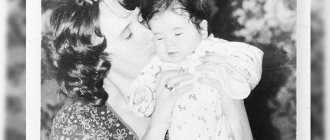Content:
- 1 Anastasia Romanovna (Zakharyina – Yuryeva)
- 2 Marfa Vasilievna Sobakina
- 3 Anna Alekseevna Koltovskaya
- 4 Anna Grigorievna Vasilchikova
- 5 Vasilisa Melentyeva
- 6 Maria Feodorovna Naked
The exact number of wives of Ivan the Terrible is still not known. Different sources indicate different numbers. The most common version is about the seven wives of the king.
One thing is certain - only the first four marriages were legal from the position of the Orthodox Church. However, subsequent marriages were illegal and took place without a wedding, or the wedding was illegal.
Strictly speaking, Orthodoxy allows only three marriages, even disapproving of the third. However, Tsar Ivan’s third wife (Marfa Vasilievna) died two weeks after the wedding, and he decided to marry Anna Koltovskaya for the fourth time. To do this, he convened a Council in Moscow in 1572, at which he asked the clergy for permission for another marriage, arguing that Marfa Vasilievna never managed to become his full-fledged wife, remaining a virgin. As an exception, the council granted the king's request.
Thus, Ivan the Terrible had four life partners who had the right to officially be called queens and his legal wives. The rest were de jure his mistresses and cohabitants.
How Tsarina Anastasia made Ivan not the Terrible for thirteen years
Ivan, the future Terrible, was an impressionable and very emotional boy from childhood. He lost his father early, but he was hit much harder by the unexpected death of his mother, Elena Glinskaya, at the age of eight - with the subsequent oppression and execution of her comrades. The young king was actually imprisoned in chambers and sometimes they forgot to feed him. The new guardians, without hesitation, insulted him, slapped him in the face and walked at the expense of the royal treasury. It is not surprising that the boy became embittered, and now his favorite pastime was to get a cat somewhere and throw it out the window so that it would break on the stone slabs.
When, at the age of thirteen, Ivan gave the order to tear one of his tormentors to pieces with dogs - and this order was carried out, he realized that now no one had power over him and everyone, except his guardians, perhaps, was waiting for him to show his royal power. Subsequently, he executed many boyars. But first, at the age of sixteen, he decided to get married and organized a viewing of brides. Before the review, he accepted the wedding ceremony for the Grand Duchy.
N.K. Cherkasov - Ivan the Terrible. Film 'Ivan the Terrible'. 1943
According to legend, at the show Ivan was presented with a crowd of brides of several hundred people; he was not too lazy to look into each person’s face. One very tiny (which was then considered a flaw) girl attracted his attention - both with her beauty, and with her unusually thick dark braid, and with the expression of her eyes. Anastasia Zakharyina-Yuryeva (later her family would become the Romanovs) was, like Ivan, an orphan and approximately his same age. He chose her.
According to Russian superstitions, cruelty to cats was a sure sign of cruelty to women. There was another bad sign: the boyars hated the queen. By taking the daughter of his late servant, Ivan, in their opinion, humiliated them all. And yet, the years of marriage between Ivan and Anastasia became the best years of his life and the lives of his subjects.
Anastasia’s miraculous influence on the unbalanced teenager and man was attributed to everything: the magic of meekness, the charm of chastity, special piety... But it is worth recognizing that in reality two factors played a role: the king and queen sincerely loved each other (and, perhaps, fell in love at first sight ) and the queen was a good psychologist. She knew how to monitor her husband’s condition and calm him down in time. Anger attacks have become rare. Grozny took all the most important political steps during his first marriage - under Anastasia.
Still from the film “Ivan the Terrible” Nikolai Cherkasov in the role of Ivan the Terrible and Lyudmila Tselikovskaya and the role of Tsarina Anastasia Romanovna
Anastasia also used her talent to win over the courtiers - very soon many dissatisfied people became her ardent supporters. And yet she still had enemies.
For example, Anastasia was at enmity with the politician and priest Sylvester. Sylvester's supporters compared her to the wicked Byzantine Empress Eudoxia - they say that holiness stings her eyes. In fact, Sylvester was jealous of the Tsar for Anastasia; he was sorry to lose his influence on young Ivan.
Anastasia’s main concern, of course, was not her husband—she didn’t see him every day. The queen, according to the custom of her time, did a lot of embroidery in the mansion. But she approached this matter much more thoroughly than the boyars’ daughters and wives. A workshop literally worked in her chambers - together with the queen, her retinue sewed.
Now about a dozen works from Tsarina’s workshop have been preserved - they are in museums in Russia. All of them are recognizable in style and for their time were made with very high artistic skill - this is not counting the fact that the queen could not spare expensive materials for the manufacture of her canvases. She meticulously chose topics, choosing important state events or the history of the Rurikovichs.
In fact, Anastasia can be considered the owner of the first secular art workshop in Rus', specializing specifically in historical paintings. Not only women worked for her; male icon painters from different schools and even lands were brought in to create sketches.
Due to the affection of her husband, whom Anastasia never lost, she had to give birth quite often - every two years. Therefore, when Anastasia fell ill after another birth, they said that it was from general weakness - she could not stand giving birth in a row. This has happened. But the king, whose mother had once been poisoned by conspirators, now suspected a conspiracy. As the analysis of Anastasia’s remains will show in our time, it’s not in vain. The queen was poisoned with mercury.
Monument to the founder of the city, Tsar Ivan the Terrible, Orel
Her death was a huge grief for her subjects and the king. Hundreds of people were crying at the coffin. The beggars mourning the queen refused to take funeral alms: we are not crying for money, they say. The thirty-year-old king himself could barely stand on his feet and could not stop sobbing. He was literally led by the arms. The boyars did not yet know that they were burying not only the hated queen, but also good times. After the murder of Anastasia, there was nothing sacred left in Ivan. Just anger at the world, endless, boundless anger.
Photo: TASS/Alexey Borodin
Another story of the legendary wife of the head of state - Raisa Gorbachev: the main woman of the first president.
Anastasia Romanovna (Zakharyina – Yuryeva)
years of life 1530 - 1560
married 02/03/1547 – 08/07/1560
The first wife of Ivan the Terrible. He married her immediately after his accession to the throne, at the age of sixteen. Mother of the last representative of the Rurik dynasty, Fedor I Ioannovich (Blessed). She gave birth to six children in total, most of whom died in infancy.
The choice of the chosen one was carried out using a review of brides - a method introduced into practice by Ivan's father Vasily III, who adopted this tradition from the Byzantines. However, many question the impartiality of the choice, given the influence of the bride’s family. The fact is that Anastasia’s father was a detour under the father of Ivan the Terrible. Her uncle, who was the guardian of young Ivan, had even greater influence.
Anastasia Romanovna came from a noble family of the Zakharyins-Yuryevs. This family is well known to us under the name of the Romanovs - that’s what they were called later. Anastasia's marriage and close relationship with the last king of the Rurik dynasty undoubtedly elevated the Romanov family even more, and, after the suppression of the Rurik dynasty, gave them the opportunity (not unsuccessfully) to claim the throne - in 1613 the Romanovs ascended the throne.
According to eyewitnesses, Anastasia Romanovna, despite her small stature, was unusually attractive. She had a gentle but decisive character, exerting a significant influence on her hot-tempered and unpredictable husband. She had many ill-wishers from among the boyars, who considered the marriage unequal and the queen’s origins not noble enough. Despite this, thirteen years of marriage, according to contemporaries, were happy for both spouses.
In 1559, Anastasia suddenly fell ill and died in August 1560. The king was very sad about the death of his wife and even cried at the funeral. Her death left a significant mark on his already not entirely healthy psyche, exacerbating his paranoia to the limit. He suspected his immediate circle of poisoning his wife and became very angry and irritable. It was the death of the queen that pushed the king to begin terror against the boyars and caused many ruined lives.
However, recent data have proven that the king’s paranoia was not unfounded. A study of the queen's remains showed the presence of a huge concentration of arsenic, mercury and lead in the hair, decay and remains of funeral clothing, which clearly indicates the fact of poisoning.
Second wife: Maria Cherkesskaya
The Tsar in Rus' was not supposed to live without a wife. In 1560, the search for a new queen began. The choice fell on the young princess, Maria Temryukovna. The daughter of the Circassian prince Temryuk was 16 years old, and marriage with the Russian Tsar was hardly the limit of her dreams. But they became an “ideal couple”; the common interests of the spouses were torture and executions.
Boyarskaya said that in her youth she loved to visit nightclubs
“My life has become digital!”: the girl spoke about quarantine existence
Fans don’t recognize their favorite actor Fyodor Dobronravov: Budko has aged a lot
Maria had incredible, bright and bewitching, fabulous beauty. Perhaps this is how she seemed compared to the rather faded-looking Slavic women. But be that as it may, the king adored his young wife, she turned him around as she wanted. Maria quickly learned Russian and realized the power she had.
If Anastasia invariably extinguished attacks of anger, suspicion and cruel aggression, to which Ivan Vasilyevich was prone, then Maria did the opposite. She kindled and intensely fed all the base qualities of her husband. Maria participated in torture and was always present at executions. Historians believe that she “selected victims” from their pair, indicating to the king those who should be arrested and executed.
Maria gave birth to a son named Vasily. The child died at 2 months. The marriage lasted seven years and was very difficult. According to contemporaries, after the death of the child, the couple lost interest in each other, but they continued to be united by common inclinations.
Maria fell ill and died suddenly. Her death is a big mystery. They buried her next to the first queen. Mary's sarcophagus was placed to the left of Anastasia's tomb.
Maria Temryukovna (Circassian Princess Kuchenei)
years of life 1545 – 1569
married 08/21/1561 – 09/06/1569
Second wife of Ivan the Terrible, daughter of Prince Temryuk. Before baptism she bore the name Kuchenei. She gave birth to her only child (son) in 1563 - he died at the age of two months. This was the only dynastic marriage of his legal marriages - in other cases, the choice of the chosen one was carried out by viewing the brides.
The tsar began his search for his next bride a little more than a week after the death of his first wife Anastasia Romanovna, with whom, according to contemporaries, he lived for thirteen happy years, and at whose funeral he sobbed terribly. At first, Tsar Ivan intended to marry the sister of the Polish king Catherine, but he demanded in exchange for this several Russian regions - Smolensk, Novgorod, Pskov. Considering that the Polish bride was not worth such expenses, the tsar abandoned this intention. Then his attention turned to the Caucasus. There the Circassian princess was chosen.
This marriage was strikingly different from the previous one. Having a wild disposition and incredibly cruel, she, according to contemporaries, pushed her husband to more and more bloody savages. It is she who is credited with the idea of creating the oprichnina.
However, the king was not long captivated by the beauty of the Circassian princess. Very soon his feelings for her cooled down, and he plunged headlong into shameless fornication.
Maria Temryukovna died suddenly in September 1569. As in the case of his first wife, the king was sure that Maria had been poisoned, which could not but cause in him another attack of frenzied animal rage, and, as a result, another wave of terror.
Maria Temryukovna-Cherkasskaya
In 1560, Ivan the Terrible sent ambassadors to look for a new bride for him from the Circassian princes. Despite the fact that the tsar began to think about a new lover a few weeks after the death of his former wife, he hardly recovered from the loss of Anastasia Zakharyina. As a result, Maria Temryukovna (Princess Kuchenei before baptism) was chosen as the bride, the daughter of the Kabardian Prince Temryuk, a sixteen-year-old beauty.
Ivan the Terrible always chose beautiful women, but historians note that Maria Cherkasskaya had amazing, special beauty. At first she didn’t know a word of Russian, but after some time she learned the language. She could turn Ivan the Terrible against people she did not like. She also loved watching executions; it gave her a strange pleasure.
The wife evoked ambiguous feelings in Ivan the Terrible: on the one hand, they were similar, but on the other, she was illiterate, vindictive and cunning. So their family life was not easy. Over time, Ivan the Terrible began to grow cold towards his wife. In addition, Ivan the Terrible had a harem, and the queen also had lovers. But one day Maria fell ill, most likely with pneumonia, and died. The king and his entourage were sure that she was poisoned.
Marfa Vasilievna Sobakina
years of life ? – 11/13/1571
married 10/28/1571 – 11/13/1571
The third wife of Ivan the Terrible, chosen by him as a result of a bridal show, to which several thousand applicants were brought from all cities of Russia. She came from a seedy noble family from Kolomna.
Her numerous relatives rose significantly after this marriage, but, ultimately, it did not bring them happiness - after Martha’s death, someone was executed (which was not uncommon at that time), and someone was forcibly tonsured a monk.
The marriage with Martha did not last long - she died fifteen days after the wedding. The king, as in previous cases, suspected poisoning. Dozens of suspects were subjected to brutal execution.
In our time, examination of Martha’s remains has not revealed the presence of poisons. However, if it was poisoned by plant poisons, then the past centuries should have erased their traces.
Marfa Sobakina
Ivan the Terrible organized a brideshow: two thousand of the most beautiful girls were brought to Alexandrovskaya Sloboda. First, the king selected 24 beauties, then 12. The “competition” was serious: first the girls were examined by grandmothers, then by doctors. Marfa Sobakina turned out to be the healthiest, most desirable and beautiful. On June 26, 1571, the king announced his engagement. At this time, Ivan the Terrible relied heavily on Malyuta Skuratov.
It was Malyuta who recommended the bride to Grozny, who, thanks to this marriage, became related to the royal family. At his wedding with Marfa, his wife and daughter were matchmakers, and Malyuta himself and his son-in-law Boris Godunov were groomsmen. However, the bride fell ill almost immediately. The illness lasted two weeks, after which Martha died. The reasons for her death are unknown, although there are many versions: poisoning, a mysterious potion, witchcraft... But almost nothing is said about natural death.
Anna Alekseevna Koltovskaya
years of life ? – 04/05/1626
married 1572 (April) – 1572 (September)
The fourth and last legal wife of Ivan the Terrible. Daughter of nobleman Alexei Koltovsky. He married her after the sudden death of his previous wife, Marfa Sobakina. The canons of Orthodoxy do not recognize the fourth marriage as legal. Therefore, in order to legitimize this procedure, the king convened a church council, from which he asked permission for the wedding. As an exception, they received it.
Anna Alekseevna was noticed by the tsar at the previous bridal show, when his choice fell on Marfa Sobakina. After the death of the latter, she was called to the king.
The marriage to Anna did not last long. The king quickly lost interest in her and less than six months later divorced her in the usual way for monarchs - she was imprisoned in a monastery and tonsured as a nun. The reason for the discord in this married couple is not reliably known.
Her relatives, exalted after the wedding, were killed.
Anna (Daria in monasticism) was destined to significantly outlive her husband - she died only in 1626.
How many wives did Ivan the Terrible have?
Ivan the Terrible first married Anastasia Romanovna at the age of 17. She was destined to become the first Russian queen. This marriage lasted 13 years. Anastasia gave John six children, most of whom died in early childhood. The most famous children from his marriage to Anastasia are the princes Ivan, who was killed by John in a quarrel, and Fyodor. Anastasia died a violent death, presumably poisoned by the boyars. A few days after Anastasia’s death, the tsar expressed a desire to marry a second time. A traditional viewing of brides was organized, and the king’s choice fell on the Kabardian beauty Maria Temryukovna, and a year later their wedding took place. According to contemporaries, the new queen was a very cruel, dissolute and treacherous woman. The marriage lasted a little over eight years and ended with the death of Mary. Historians believe that she was poisoned by the tsar himself, who, however, blamed the boyars for everything.
The third wife of Tsar John was Marfa Vasilievna Sobakina in 1571. Shortly before the wedding, she fell ill, but they decided not to postpone the wedding. Martha remained Queen for only two weeks. She died without ever knowing the marriage bed. The king suspected that she was poisoned by the brother of his previous wife, and ordered the murderer to be impaled.
The third marriage, according to Orthodox custom, was supposed to be the last, but Ivan the Terrible convinced the Metropolitan that “he never became Martha’s husband.” And in 1572, the Metropolitan allowed John to get married for the fourth time. His chosen one was Anna Koltovskaya. Soon after the wedding, at the instigation of the boyars, she was exiled to a monastery and forcibly tonsured a nun. She was the luckiest of all - she died of natural causes in 1626, outliving Ivan the Terrible by more than forty years.
John no longer asked permission for a fifth marriage from the clergy. The wedding ceremony was performed by Archpriest Nikita, who previously served in the guardsmen. Maria Dolgorukaya became the fifth wife of Ivan the Terrible in 1573. This marriage lasted less than a day. After the first wedding night, it turned out that Mary was not a virgin, and in the morning the king took the tied-up queen in a sleigh to the Aleksandrovskaya Sloboda and drowned her in an ice hole.
In 1575, Ivan’s sixth marriage took place with young Anna Vasilchikova. Like the previous one, this marriage was not recognized as legal, and less than a year later the young wife got tired of the king, he sent Anna to a monastery, where she soon died under strange circumstances.
The seventh wife of Vasilisa Melentyev also did not remain queen for long. John caught her in bed with her lover and cruelly punished his unfaithful wife for adultery. According to legend, he buried Vasilisa alive in the same grave with her dead lover.
In 1580, Ivan Vasilyevich took a fancy to Maria Nagaya, she became the eighth and last wife of Ivan the Terrible. Maria managed to give birth to Ivan's last son, Tsarevich Dmitry, soon after which she became unwanted and was exiled to a monastery, where she lived until 1612.
Contemporaries called Ivan the Terrible “lascivious” and “depraved.” According to descriptions of the appearance and general condition of the cruel king, in the last years of his life he was probably sick with syphilis. At the age of 41, at the time of his marriage to Marfa Sobakina, John looked like a sick old man. And at the age of 53, just before his death, he could no longer walk on his own.
Anna Grigorievna Vasilchikova
years of life ? — 1577
married late 1574 – 1575
She came from the Vasilchikov family of nobility. Strictly speaking, she cannot be called a royal wife, since the wedding took place contrary to the rules of the Orthodox Church, which prohibits a fourth marriage.
Therefore, the wedding was not held according to royal rank - the great boyars were absent from it, and all those invited were from the closest circle.
Less than a year later, the king lost interest in Anna, and she was forcibly tonsured a nun. A year later she died in the Suzdal Intercession Monastery.
Anna Vasilchikova
One day, Ivan the Terrible visited Prince Pyotr Vasilchikov, where he took a liking to the prince’s seventeen-year-old daughter Anna. And without thinking twice, he suggested to the prince to send the girl to the palace. The father was against it, but Ivan IV simply sent matchmakers the next day.
So Anna Vasilchikova became his wife. This marriage was not recognized by the church, and she was not perceived as a queen either. Family life lasted three months. Then - the sudden death of a previously completely healthy girl. It was announced that it was a “chest illness.” But the body was still taken out of the palace secretly, at night, and sent to the Suzdal nunnery for burial.
Vasilisa Melentyeva
years of life ? – 1578/59(?)
married late 1575 – 1577 (?)
Information about her is extremely limited. Many historians are generally inclined to consider this character fictional. According to the information that has reached us, she was a widow from Moscow, distinguished by incredible beauty. She became the king's wife without any wedding ceremony, which gives reason to call her rather a concubine and concubine, but not a wife and, of course, not a queen.
She was exiled to a monastery, the name of which has not been preserved by history. The burial place of Vasilisa is also unknown.
We create communication
On October 28, 1571, Tsar Ivan Vasilyevich married for the third time, taking as his wife Marfa Sobakina, who won the “bride show.”
The personal life of Russian leaders in all centuries has not been particularly stormy. Passions of love are categorically contraindicated for Russian leaders - the people do not favor “immoral” leaders. And the Orthodox Church does not approve of wives being changed like gloves. That is why the personal life of Tsar Ivan the Terrible stands apart, whose love stories are more suitable for a Hollywood star than for a Russian monarch.
Historians disagree on how many wives Ivan IV had in total - based on different criteria, we can talk about four, five, or even eight.
Anastasia Zakharyina-Yuryeva
It is unlikely that young Ivan Vasilyevich, crowned king in 1547 at the age of 17, could have imagined how stormy his relationships with women would be.
On the contrary, the young man, who lost his father and mother early, strove for warmth and family comfort.
Immediately after Ivan’s crowning, a bridal show was announced, in which “boyar daughters” from all over the country could take part.
This method was not new - it was once used by Ivan’s father Vasily III, who adopted the tradition from the Byzantine emperors.
The winner of the “competition” was Anastasia Romanovna Zakharyina-Yuryeva, the niece of one of the guardians of the young Ivan IV.
The Zakharyin-Yuryev family, later nicknamed the Romanovs, will in the near future create a new royal dynasty. However, in 1547, when 17-year-old (according to other sources - 15-year-old) Anastasia married the young king, hardly anyone thought about the imminent suppression of the Rurik dynasty.
The young queen, unwittingly, irritated the influential boyars. The Zakharyin-Yuryev family at that moment was not among the highest Russian nobility, and the elite considered the choice of the Tsar as a spit in their face.
But Tsar Ivan was happy. Anastasia did not get involved in political affairs, but she could calm the hot-tempered king, which had a beneficial effect not only on her wife, but on the entire state.
However, the queen felt personal hostility towards two persons from among her husband’s inner circle - Archpriest Sylvester and the devious Alexei Adashev. Anastasia had reasons for this. In 1553, during the Tsar’s serious illness, when it came to the question of an heir, both Sylvester and Adashev were ready to swear allegiance not to Ivan’s son, but to the Tsar’s cousin, Prince Vladimir Staritsky.
Anastasia bore her husband six children, but only two sons, Ivan and Fyodor, survived to adulthood. Ivan, who for many years was considered the heir to the throne, died under tragic circumstances, most known from the film “Ivan the Terrible Kills His Son.” Fedor became the last tsar from the Rurik dynasty.
Queen Anastasia spent a lot of time doing embroidery and had her own workshop. Art historians who have studied the works made in the queen’s workshop consider them real masterpieces. The first wife of Ivan the Terrible had an undoubted talent as an artist.
The queen's health was undermined by childbirth and illness. In 1559, Anastasia fell especially seriously ill. In August 1560, after 13 years of marriage, the queen died.
Ivan the Terrible believed that his beloved wife had become a victim of poisoners. Modern scientists who conducted a study of Anastasia’s remains in 2000 believe that these suspicions are well founded. Spectral analysis of the queen’s preserved dark brown braid showed an abnormally high content of mercury, the favorite weapon of poisoners of the era of Ivan the Terrible.
One way or another, Anastasia’s death had the most serious impact on the tsar, and with him on the country. There was no one to restrain the anger of Ivan the Terrible. In addition, confident that Anastasia had become a victim of murderers, the tsar began to carry out harsh repressions against those whom he considered his enemies.
Maria Temryukovna
After the death of Anastasia, Ivan the Terrible, as they say, began to “go downhill.” Contemporaries even openly said that the king had fallen “into fornication.” At the same time, none of the subsequent wives could even come close to comparing with the first wife, for whom Ivan IV, obviously, yearned for his entire subsequent life.
The boyars of Ivan the Terrible, having gotten rid of Anastasia, whom they hated, already eight days later invited the tsar to find himself a new wife. Of course, they referred to state interests.
A new bride was found in the Caucasus - Princess Kuchene, daughter of the Kabardian prince Temryuk. A 15-year-old beauty from the Caucasus who arrived in Moscow charmed the tsar, and on August 21, 1561, the wedding took place in the Assumption Cathedral of the Kremlin.
Previously, as was always done in such cases, the princess was baptized into Orthodoxy under the name Maria Temryukovna.
In March 1563, Queen Maria gave birth to her husband’s son, who was named Vasily, but the baby died at the age of two months.
The king's second marriage did not live up to his expectations. Maria Temryukovna could not replace Anastasia for him. Moreover, contemporaries believe that the temperamental mountain woman did not calm, but rather incited the king’s anger towards those whom he considered “enemies.”
Maria Temryukovna died on September 6, 1569 in Alexandrova Sloboda after returning from a long trip to Vologda. The Tsar again suspected the machinations of the boyars in this death, although there is no reason to assert that the second wife of Ivan the Terrible shared the fate of the first.
Marfa Sobakina
As already mentioned, the Orthodox Church was extremely sensitive to issues of marriage. Even for a second marriage, permission was not so easy to obtain, the third was permitted in exceptional cases, and the fourth could not be discussed under any circumstances.
After the death of his second wife, Ivan the Terrible decided to approach his “last chance” with all seriousness. In 1571, a new review of brides was announced, similar to the one at which the first wife of Ivan the Terrible was chosen.
This time, more than 2,000 girls took part in the selection, each of whom was personally presented to the monarch. In addition to the interview, the candidates were also subjected to a medical examination.
Deciding to take advantage of the opportunity, the tsar arranged the personal life of his son as well - one of the candidates, Evdokia Saburova, was given as a wife to Tsarevich Ivan Ivanovich.
The 41-year-old Tsar himself chose Marfa Sobakina, the daughter of a poor Kolomna nobleman.
It was with Tsarina Marfa Vasilievna that the manager Bunsha from Gaidaev’s comedy “Ivan Vasilyevich Changes His Profession” tried to retire in a separate office, posing as the Tsar.
In fact, what happened was not a comedy, but a tragedy. After her betrothal to the Tsar in June 1571, Marfa Sobakina became seriously ill, and her condition only worsened. The Tsar, however, did not cancel the wedding - it took place on October 28, 1571 in Alexandrovskaya Sloboda.
The status of Queen Martha did not help: she died just 15 days after her wedding with Ivan the Terrible. The king, of course, again suspected the machinations of his enemies, and the fate of those who were under suspicion was unenviable.
Anna Koltovskaya
As already mentioned, the church could not allow the fourth marriage. But the stubborn king found a way out, declaring that marriage with Martha could not be considered a marriage, since due to illness he was not intimate with her.
Grozny put pressure on the church first hierarchs, who confirmed his right to a new marriage.
There were no problems with the new bride - she was the daughter of the nobleman Koltovsky, Anna, who took second place at the bride show after Marfa Sobakina. There were no magnificent celebrations this time, but in May 1572, the 41-year-old Russian Tsar again became a married man. The new wife was about 16 years old at that time.
After such cunning maneuvers that Ivan the Terrible went to in order to achieve this marriage, one could expect that it would last at least no less than with Maria Temryukovna. But in fact, already in September 1572, Queen Anna was removed to a monastery and soon tonsured as a nun with the name Darius.
It is unknown how the young queen angered her husband. Such a short period of marriage excludes the most terrible accusation for royal wives - infertility. By that time, Ivan the Terrible himself no longer considered it necessary to explain anything to anyone. Therefore, oddly enough, many researchers believe that the young beauty simply got tired of the adult man after four months. The king, who had previously sought recognition of the marriage as legal, soon easily declared it illegal, getting rid of his wife.
The fourth wife of Ivan the Terrible outlived not only himself, but also all his other wives, as well as children, the Time of Troubles, and died in 1626, when the first representative of the new Romanov dynasty had already established himself on the throne. For many years, Daria was the abbess of the Tikhvin Vvedensky Convent.
Maria Dolgorukaya
The king's fourth marriage was the last, which was formally recognized by the church. Further, the Orthodox Tsar “fornicated”, giving up on any legality in this matter.
Maria Dolgorukaya is the most dubious character on the list of the king’s illegitimate wives. The story about her is not supported by any convincing evidence.
Allegedly, in November 1573, Ivan the Terrible took 14-year-old Maria Dolgorukaya as his wife. However, on his wedding night, the monarch discovered that his passion was not a virgin. The angry king ordered Mary to be tied to a cart with horses, which was sent into the lake, where the unfortunate woman drowned.
However, most historians believe that this story is a myth, “promoted” by the whistleblowers of Ivan the Terrible.
Anna Vasilchikova
Unlike Dolgorukaya, Anna Vasilchikova is a real character. Ivan the Terrible became close to a representative of the Vasilchikov noble family in 1574 and a few months later married her, without demanding the blessing of the church. Due to the illegal status of the new royal wedding, many influential people were not present at it, but only “the king’s inner circle.”
In fact, Anna Vasilchikova did not have a single chance of maintaining the Tsar's favor for a long time. The king stopped taking marital relations seriously - having the opportunity to give his favorites a high status, he did not refuse it, but with the same ease he deprived his boring passions of everything.
“Anna the Second” lasted about a year, after which she shared the fate of “Anna the First” - she was forcibly tonsured a nun in the Intercession Monastery in Suzdal. Unlike Koltovskaya, Anna Vasilchikova did not live long in disgrace, dying in 1577 in the same monastery where she took monastic vows.
Vasilisa Melentyeva
As in the case of Maria Dolgoruky, the very existence of this wife of Ivan the Terrible is called into question by historians.
The famous historian Sergei Solovyov, without denying the existence of Vasilisa Melentyeva, writes that we “do not have the right to call the tsar’s two concubines, Anna Vasilchikova and Vasilisa Melentyeva, queens, because he did not marry them, and in modern monuments they are not called queens.”
If we accept the existence of Melentyeva as truth, then the following should be said. Her rapprochement with the tsar occurred after the tsar lost interest in Anna Vasilchikova. Unlike other women of Ivan the Terrible, Vasilisa was a widow, but this did not bother the king at all.
Vasilisa Melentyeva shared the fate of her predecessors - after several months of an affair with the tsar, she fell into disgrace, was tonsured as a nun and died in a monastery.
Maria Nagaya
In 1580, 50-year-old Ivan the Terrible made a last attempt to streamline his personal life by marrying the 27-year-old daughter of the okolnik Fyodor Fedorovich Nagogo-Fedets, Maria. The bride's uncle was the tsar's close associate Afanasy Nagoy, who served as the Russian ambassador to Crimea.
The marriage, of course, was not consecrated by the church, but the wedding took place quite officially, although it was attended exclusively by representatives of the tsar’s “inner circle.”
Queen Maria simply did not have time to fall into disgrace with her husband. Ivan the Terrible, according to researchers and according to the testimony of foreign ambassadors at the Russian court of that time, by the age of 50 was already a decrepit old man, suffering from a whole bunch of various diseases.
Despite this, Maria gave birth to her husband a son in October 1582, who was named Dmitry . The fate of the youngest son of Ivan the Terrible was no less tragic than that of his brothers - at the age of 8 he died in Uglich. The death of Tsarevich Dmitry was one of the causes of the Time of Troubles.
Not everyone knows, however, that the prince ended up in Uglich with his mother at the behest of his brother Fyodor, who ascended the throne in 1584 after the death of his father.
Tsar Fyodor Ivanovich did not feel love for his younger brother or stepmother. Moreover, from the point of view of the church, Dmitry was illegitimate and could not lay claim to the throne. The city of Uglich was given to him as a reign, where he was formally considered the sovereign master.
Maria, who survived her husband, did not escape the fate of being tonsured as a nun. She was given such a punishment “for neglecting” her deceased son.
The Dowager Queen, who became the nun Martha, will be one of the main characters in the Time of Troubles, when her “miraculously saved son” - False Dmitry I - appears on the stage.
A woman entangled in intrigue, who lost her only son, died in 1611, at the end of the Time of Troubles. Five years earlier, Tsarevich Dmitry was canonized by the Orthodox Church.
AiF
Maria Fedorovna Nagaya
years of life 1553 - 1611
married late 1580 – 1584
The last wife of Ivan the Terrible, who was with him until his death in 1611. One child was born in the marriage - Tsarevich Dmitry Uglitsky. Comes from the boyar family Nagikh.
After the death of Ivan the Terrible, she, along with her numerous relatives, was exiled to Uglich, given to the prince to reign. In 1591, Tsarevich Dmitry, the only heir of Tsar Fedor, died mysteriously. During the riots that began, Maria Fedorovna accused several people of her son’s death, and they were torn to pieces by the crowd. The murder of these unfortunates and neglect of her son was blamed on her and she was tonsured a nun under the name Martha.
Under False Dmitry I, she was returned to Moscow, where she solemnly identified him as her son. However, during the murder, False Dmitry recanted her confessions, saying that she made them under threat of death.
Login to the site
A-delina
The wives of Ivan the Terrible. Ivan the Terrible (John IV) was born on August 25, 1530. Son of Grand Duke Vasily III and Elena Vasilievna Glinskaya. After the death of his father, 3-year-old Ivan remained in the care of his mother, who died in 1538, when he was 8 years old. Ivan grew up in an environment of palace coups, the struggle for power of the warring boyar families of the Shuisky and Belsky. The murders, intrigues and violence that surrounded him contributed to the development of suspicion, vindictiveness and cruelty in him. The exact number of wives of Ivan the Terrible is unknown, but he was probably married seven times (Anna Vasilchikova was not married).
Uncontrollable from childhood, corrupted by the boyars, whom he later mercilessly executed, John was a priest of debauchery all his life. History knows only two weeks when he led any human life. These were two weeks of his first marriage. John knew women from the age of thirteen. The boyars, trying to distract him from the affairs of government, vied with each other to arrange love affairs for him. Over the course of four years, the boyars wooed him with several hundred girls.
A. Litovchenko. Ivan the Terrible shows his treasures to the English ambassador Horsey. On February 16, 1546, seventeen-year-old Tsar Ivan Vasilyevich married Anastasia Romanova-Zakharyina, his first and beloved wife, daughter of the boyar Roman Yuryevich Koshkin-Zakharyin. After her father's death in 1543, she lived with her mother. She was chosen by the Tsar himself from a large number of applicants brought from all over Russia. The hawthorns, gathered from all over the kingdom, smiling coquettishly, tried in one way or another to attract the tsar’s attention, and he chose Zakharyina, whose modesty evoked mocking smiles. The Zakharyins were not a noble family, but Anastasia captivated the Tsar with her beauty and, most importantly, her soft femininity. According to the chroniclers, “the most kind Anastasia instructed and led John in all sorts of virtues.”
A week passed, and the boyars did not recognize the king. The cruel fun with bears and jesters stopped, “shameful” songs were not heard, the girls who filled the palace’s tower disappeared. John was friendly to everyone and generously helped those in need. But John led family life for only two weeks. The married king again led a single life. He left all the affairs of government to the boyars, and he himself devoted himself entirely to hunting, cruel games, trips to monasteries and, mainly, orgies. By the end of the third week after John's wedding, the Moscow palace was again filled with women, the number of whom reached fifty. Anastasia lost all influence on her sovereign husband.
In this marriage they had six children, but only two survived. The eldest girls - Anna and Maria - died before reaching a year. Tsarevich Dmitry Ivanovich died six months later due to an absurd accident. Anastasia gave birth to her second son, Tsarevich Ivan Ivanovich, on March 28, 1554. Two years later, her daughter Evdokia was born. The son survived, but the daughter died in her third year of life. The third son in the royal family was born on May 31, 1557. Theodore Ioannovich (1584-1589) became the last Russian Tsar from the Rurik dynasty. In 1560, on August 7, Queen Anastasia died. She was ill for only three days, and the most skilled physicians could not determine her illness. They persistently said that the queen was poisoned.
On August 18, 1560, during a reception, the boyars beat the king with their foreheads and asked him to choose a second wife. John calmly listened to them and announced that he had already thought about this himself and had even chosen a bride for himself. John's attention was drawn to the young Circassian Maria (Goshaney), daughter of the Circassian prince Temgruk. Temgruk was conveyed the king’s desire to see him in the palace with his daughter. The prince has arrived. The wild beauty of the young Circassian woman turned John’s head. Maria became the bride of the Moscow Tsar. However, the wedding had to be postponed for a whole year. The princess did not speak Russian at all and was not even baptized (she received the name Maria at baptism). The wedding took place on August 21, 1561.
The new queen turned out to be the direct opposite of good Anastasia. Growing up among the Caucasus mountains, accustomed to hunting and danger, she longed for a stormy life. The quiet, dark life did not satisfy her. Maria willingly appeared in the capital chamber, attended bear-baitings with delight, and even, to the horror of the boyars, watched public executions from the heights of the Kremlin walls. Not only did she not restrain John from bloody reprisals, but she herself pushed him into them.
A. Levchenko. Maria Temryukovna is the second wife of Ivan the Terrible. The boyars did not like the new queen. In order to bind the king more firmly to her, she indulged his inclinations towards debauchery. She surrounded herself with the most beautiful girls and herself pointed them out to John. Orgies began to take place in the queen’s chambers, which had never happened before. Thus, after his second marriage, John began to lead an even more unbridled lifestyle. Maria, who encouraged debauchery, was not shy herself. Almost before John’s eyes, she changed lovers almost every day. But soon it was hinted to John that the queen wanted to overthrow him from the throne and the Tsar decided to place Mary under strict supervision. This order of the king made a strong impression on Mary. The ardent southern woman, deprived of the opportunity to satisfy her passions, began to waste away. She died on September 1, 1569.
Gorokhovskaya T. Ivan the Terrible chooses a bride. The king willingly agreed to enter into a third marriage. Hundreds of boyar families gathered in the capital. On a certain day, a review took place in the Faceted Chamber. Selected beauties stood in rows. Bald, hunched, toothless John, leaning heavily on his staff, walked around the rows of girls, vigilantly peering into their ruddy, healthy faces. The girls stood with their eyes modestly downcast, trembling with excitement. Suddenly the dull gaze of the king met open eyes. A thin, slender girl, Marfa Sobakina, looked boldly at him. In the Council verdict there is the following entry: “And I went through a lot of tests about the girls, then after a long time I chose a bride for myself, the daughter of Vasily Sobakin.”
On June 26, 1571, Tsar Ivan IV announced his engagement to Marfa Sobakina. Prince Mikhail Temgruk, the brother of the late Queen Maria, began to visit the Sobakins often. Martha got used to it. One evening Temgruk offered the hawthorn several candied fruits. Martha accepted the gift. From that day on, she, who had never been overweight, began to noticeably lose weight. In addition, she began to have seizures. The Tsar was reported about this, but he declared that he would marry Sobakina, no matter what. The wedding took place. Two weeks later, Martha died, remaining a virgin. It was to her in 1898 that N. A. Rimsky-Korsakov dedicated the opera “The Tsar’s Bride”. The massacres began. Mikhail was impaled. In addition to him, some other boyars suspected of complicity were executed. The death of Marfa Sobakina sincerely saddened John. Maybe because he hasn’t had time to get tired of his third wife yet. He spent two whole weeks in solitude, not allowing anyone near him.
Podkopaeva M. Ivan the Terrible in Alexandrova Sloboda. John had fun for a whole year after the death of Martha. Finally, he got tired of it and decided to enter into a new marriage. However, the Orthodox Church only allows three marriages, so the fourth is clearly illegal. But for John the law did not exist. He chose Anna Alekseevna Koltovskaya as his wife and ordered the priest to marry himself to her. Anna Kotlovskaya was in many respects similar to Maria Temgryukovna. Like the latter, she was distinguished by unbridledness and passion. After the frail, poisoned Sobakina, Anna managed to subordinate John to her imperious influence. For a while, the king calmed down, mass torture and executions stopped. Anna knew how to keep her formidable husband busy. In its palace half there was always a crowd of beautiful women, ready at any moment to dance and entertain the sovereign with whatever he wanted. The queen looked at these “games” calmly. She did not know how to be jealous, because John, as a husband, was indifferent to her.
Vasily Surikov. Visit of the princess to the convent. 1912. Anna fought against the oprichnina, which many of the tsar’s close associates did not like. Not much time later, the boyars advised the tsar to send Anna to a monastery. Queen Anna ceased to exist. What remained was the humble nun Daria, ordained into the schema. When she was carried out of the temple, an ominously white skull appeared on her chest. Her head was covered with a hood, which also had a skull embroidered on it. She was buried alive in one of the monastery crypts, where she lived for another 54 years. She died in August 1626, after the reign of the Romanov dynasty.
P. Pavlov. Ivan the Terrible. To satisfy his passions, the tsar had to travel around, because, despite all his strictness, the boyars tried by all means not to allow their wives and daughters into the “single” palace. The king became convinced that he needed to marry again. In November 1573, the marriage of Ivan Vasilyevich with Princess Maria Dolgorukova took place. This marriage, the fifth in a row, turned out to be sadder than all the previous ones. The morning after the wedding, John walked into the reception room with a frown on his face. Everyone was wary, although no one knew the reason for the gloomy mood of the newlywed. Soon the news spread throughout the palace that the king and queen were leaving. Creaking its runners in the fresh snow, the royal train left the Kremlin and headed to Aleksandrovskaya Sloboda. There was at that time a vast pond overflowing with fish. Upon arrival, the king expressed a desire to fish in the lake. The king’s quirks had long ceased to amaze his subjects, but the king’s fishing in winter, with severe frost, still seemed too strange and crowds of curious people began to flock to the pond.
By noon, a good third of the pond was clear of ice. A high chair was placed at the edge of the hole. Foot and horse soldiers surrounded the pond, not allowing anyone outside on the ice. Dusk was already approaching when the gates of the palace opened and a strange procession appeared from there. The king rode ahead on horseback. He was followed by a sleigh on which Queen Mary lay. She was unconscious, but nevertheless, her body was firmly tied to the studs with a rope. The king rode onto the ice, got off his horse and sat down in a chair. The sleigh stopped on the shore. The king announced to everyone that he had not got the queen as a virgin, and after his order, Malyuta went up to the studs, took out a knife and stabbed the horse harnessed to them in the croup. The horse took a leap. The guardsmen ran up to her and began to shower her with blows. The frightened animal rushed forward, not making out the road. A few seconds later there was a splash, splashes flew, and the horse, along with the arms and the queen tied to them, plunged into the icy water.
Andrey Petrovich Ryabushkin. Ivan the Terrible with his entourage. Terribly thin, completely bald, with a face covered with wrinkled skin of a brownish-greenish color, Ivan the Terrible gave the impression of coming from the grave, and inspired horror even in those close to him. In 1575, Anna Vasilchikova became the tsar's wife. It is not even known whose daughter she was. Miller, in his essay “On the Nobility,” calls her Vasilievna, and others (for example, Khmyrov in his “Alphabetical Reference List”) consider her the daughter of Grigory Borisovich Vasilchikov, who served under the son of Grozny. That she was not married can be concluded from the fact that at the royal court, among the closest royal people, her relatives are not visible, and that in the everyday life of the Volokolamsk monastery, where it is written down according to “Anna Vasilchikova's dacha, the sovereign's hundred rubles”, she is not called a queen. After living with the tsar for two years, Vasilchikova was involuntarily tonsured as a nun in the Suzdal Intercession Monastery. She died on January 7, 1626. Her body, according to some instructions and the guesswork of the historiographer Karamzin, was buried in the Suzdal Pokrovsky nunnery.
Andrey Petrovich Ryabushkin. In the mansion. The Tsar brought the eager Nikita Melentyev closer to him. He was a crafty man who won John’s favor with his willingness to do whatever he wanted on the king’s orders. One day, John, wanting to give his pet special attention, stopped by to see him. This visit was completely unexpected for Melentyev. He, of course, fussed. A few minutes later, Melentyev’s wife, the beautiful Vasilisa, appeared in the upper room where the king was imprisoned. She fell in love with the decrepit king.
Sedov G. Tsar Ivan the Terrible admires Vasilisa Melentyeva. 1875. Two days after Melentyev’s funeral, Vasilisa appeared in the palace. This luxurious woman immediately took a leading position. She managed to charm the decrepit John, who unquestioningly fulfilled all her whims. In a short time, Vasilisa Melentyeva removed from the palace all the women in whom she could see rivals. At the same time, Vasilisa managed to keep the Tsar in a tense state all the time, not allowing him to get physically close. She pursued a very specific goal: she needed to become a queen. And she achieved her goal. The king married her. Vasilisa kept John close to her for two years. During this time, John seemed to be reborn. Executions have almost stopped. John did not travel to the Alexandrovskaya Sloboda, his seizures occurred extremely rarely, and there were no orgies in the palace.
Nikolay Nevrev. Vasilisa Melentyeva and Ivan the Terrible. 1886 But alas, Vasilisa was not without sin. One morning the king caught her with her lover in the bedroom. The next day, a funeral took place in Alexandrovskaya Sloboda. A wide grave was dug on the outskirts. The priest performing the service did not know who was lying in the two coffins that were brought from the Kremlin. They didn't even give him names. On behalf of the Tsar, Bosmanov conveyed that it was necessary to commemorate simply “the deceased servant of the Lord.” John taught the priests to obey and during the funeral service such an unusual commemoration was pronounced over the closed coffins. Only young Bosmanov was present in the church. Several times it seemed to the priest that a slight rustling was coming from one of the coffins, but he did not dare say anything. The coffins were taken out and buried in a common grave. By order of Bosmanov, the Hill was not filled up over this grave. In one of these two coffins lay Ivan Kolychev, and in the other - the living Vasilisa Melentyeva, all tied up with ropes, with her mouth tightly gagged.
Tormosov Victor. Ivan groznyj. The last marriage was concluded in the fall of 1580 with Maria (monastically Martha) Naga. They say that Maria Nagaya was such an unprecedented beauty that the king wanted to marry her the very moment he saw her. He removed the disgrace from her father, Fyodor Nagoy, and returned the entire family to Moscow. A week after the first meeting, on September 6, 1580, in the Transfiguration Cathedral, the newlyweds were crowned by the same archpriest Nikita, who also crowned the unfortunate Maria Dolgorukaya, who was drowned after her first wedding night. On November 19, 1582, the tsar’s third son, Dmitry Ivanovich, was born, who died in 1591 in Uglich. Maria Fedorovna Nagaya witnessed a truly deep drama in the life of the tsar: in November 1581, he killed his eldest son, the heir to the throne, Tsarevich Ivan Ivanovich.
Queen Martha denounces False Dmitry. Colored lithograph based on a sketch by V. Babushkin. Mid-19th century State Historical Museum In biographical studies about Ivan the Terrible, there are names of women with whom he wanted, but for various reasons could not or did not marry. So, in 1575, the tsar considered Natalya Korostova as his future wife, but met unexpected resistance from her uncle, Novgorod Archbishop Leonid. As a result, Archbishop Leonid was killed (there are several versions of his death, according to one of which he was sewn up in a bearskin and thrown to be torn to pieces by dogs), and Natalya forcibly became the prey of Ivan the Terrible, but soon disappeared without a trace. At the end of his life, being married to Maria Nagaya and deciding to send her to a monastery, Ivan the Terrible was going to marry the nieces of the English Queen Elizabeth: first, Maria Hastings (according to some reports, she was against it, and instead of her, the special envoy of the Russian Tsar in London F Pisemsky was introduced to some kind of ugly woman), and then to the young widow Anna Hamilton (this marriage was prevented by the death of Ivan the Terrible). John died suddenly in March 1584 during a game of chess. He was buried in the Moscow Kremlin, in the Archangel Cathedral. In the altar - if you stand facing it, then on its right side.
Tombstones of the burials of Tsar Ivan the Terrible, Tsarevich Ivan Ivanovich and Tsar Fyodor Ivanovich in the Archangel Cathedral. XVI century











